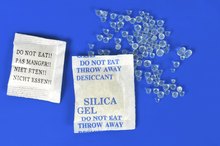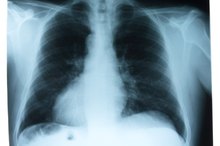Harmful Effects of Silica Gel
There are numerous harmful effects of silica gel, especially the form that contains cobalt chloride. Silica gel has the potential to harm humans, animals and the environment. Before using or disposing of silica gel products, consider the possible harmful effects associated with it.
Carcinogenic
Some forms of silica gel have been proven to cause cancer in laboratory settings, specifically the kind that contains the chemical cobalt chloride. Cobalt chloride is often added to standard silica gel to indicate the presence of water or humidity 1. When the silica gel is still active, the cobalt content causes it to remain blue, making it easier to assess water saturation. Although the silica gel encountered in household products typically does not contain cobalt chloride, its use is widespread in many public settings such as parks. Silica gel alone has not been proven to cause cancer.
- Some forms of silica gel have been proven to cause cancer in laboratory settings, specifically the kind that contains the chemical cobalt chloride.
Ingestion
What Happens if Silica Gel Is Ingested?
Learn More
Ingesting silica gel causes dehydration and discomfort since the main purpose of the product is to absorb water, but only if a lot is swallowed. In all likelihood the most irritation will occur to the mouth and throat as the product is swallowed. If consumed in large quantities, silica gel has been said to cause stomach upset. However, as long as the silica gel does not contain cobalt chloride, it is actually not poisonous to the body.
- Ingesting silica gel causes dehydration and discomfort since the main purpose of the product is to absorb water, but only if a lot is swallowed.
- However, as long as the silica gel does not contain cobalt chloride, it is actually not poisonous to the body.
Eye Sensitivity
Silica gel causes irritation and redness when contact with the eyes occurs. Pain will also arise as the silica gel attempts to absorb fluids on the surface of the eye. Wearing goggles reduces this risk; however, if contact does occur, the eyes must be rinsed out with water for at least 15 minutes to completely remove the silica gel.
Respiratory Effects
Dangers of Talstar
Learn More
Inhaling silica gel is highly dangerous and requires immediate medical attention. The warning labels on common silica gel packets found in household items are actually there because of respiration concerns, not poison issues, as many people believe. A child who attempts to eat silica gel may actually inhale some of the beads, causing severe lung irritation, shortness of breath and coughing. Repeated long-term exposure to the dust form of silica gel causes the lung disease silicosis, which damages the lungs permanently.
- Inhaling silica gel is highly dangerous and requires immediate medical attention.
- Repeated long-term exposure to the dust form of silica gel causes the lung disease silicosis, which damages the lungs permanently.
Skin Irritation
Irritation and redness occurs from touching silica gel, and dryness and skin abrasions will result if extended exposure occurs. Always protect hands and bare skin from silica gel, including from potential secondary exposures due to touching clothing or other items that have come into contact with it.
Environmental Hazards
Silica gel is thought to cause harm to the environment, especially aquatic animal life and water sources. Cobalt chloride-containing silica gel is an especially hazardous waste and should be disposed of as such to limit these harmful environmental effects. While some manufacturers have created silica gel with lower amounts of cobalt chloride in an attempt to reduce hazards, one company, Nantong OhE Chemicals, has created a unique silica gel product, Eco Blue, which indicates water saturation without using any of the harmful component cobalt chloride.
Related Articles
References
- National Park Service: Cobalt Indicating Silica Gel Health and Safety Update
- Veterinary Support Personnel Network: Common Household Hazards
- Martin, KR. The Chemistry of Silica and Its Potential Health Benefits. Journal of Nutrition, Health, and Aging, 2007.
- Martin, KR. Silicon: the Health Benefits of a Metalloid, Journal of Metal Ions in Life Sciences, 2013. DOI: 10.1007/978-94-007-7500-8_14.
- Nieves, JW. Skeletal Effects of Nutrients and Nutraceuticals, Beyond Calcium and Vitamin D, Osteoporosis International Journal, 2013. DOI: 10.1007/s00198-012-2214-4.
- Ravin, Jugdaohsingh et al. Dietary Silicon Intake and Absorption, The American Journal of Clinical Nutrition, 2002. DOI: 10.1093/ajcn/75.5.887.
- Supannee, Sripanyakorn et al. The Comparative Absorption of Silicon From Different Foods and Food Supplements, British Journal of Nutrition, 2009. DOI: 10.1017/S0007114509311757.
Writer Bio
Rebecca DeLuccia-Reinstein has been a freelance writer since 2004. She is a native New Yorker based in Pennsylvania. Her writing includes books, manuals, training guides and articles published as a ghostwriter and she has covered topics such as education, sales, art and psychology. She received a Bachelor of Arts in psychology from the State University of New York at Albany.







